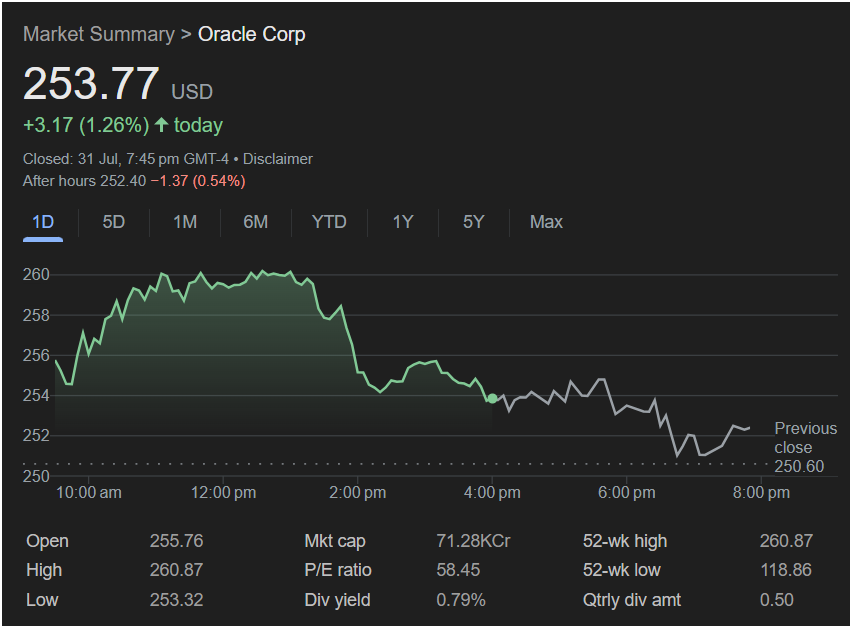Oracle Stock Hits 52-Week High as AI and Cloud Surge Redefine Its Future

AUSTIN, Texas — Oracle Corporation (NYSE: ORCL) is making headlines once again after its stock soared to a new 52-week high of $260.87 on July 31, 2025, before closing the day at $253.77—a 1.26% gain. While the stock dipped slightly in after-hours trading, Wall Street’s growing confidence in the enterprise tech behemoth remains strong. The catalyst? Explosive growth in Oracle’s cloud infrastructure, bold bets in artificial intelligence, and ambitious moves in the healthcare technology space.
 Oracle’s Cloud Surge: The Fuel Behind the Rally
Oracle’s Cloud Surge: The Fuel Behind the Rally
The backbone of Oracle’s current momentum is its impressive transformation into a modern cloud powerhouse. The company reported fiscal 2025 revenues of $57.4 billion, up 8% year-over-year. More notably, Q4 revenue came in at $15.9 billion, up 11% and exceeding Wall Street expectations. This robust growth underscores the company’s successful pivot to cloud services, with Oracle Cloud Infrastructure (OCI) and Software-as-a-Service (SaaS) leading the charge.
Cloud Infrastructure Growth: 52% YoY in Q4
Oracle’s Cloud Infrastructure (IaaS) revenue grew by a staggering 52%, reaching $3.0 billion in Q4. Total cloud revenue (including SaaS) surged 27% to $6.7 billion, firmly establishing Oracle as a serious contender in the cloud race alongside giants like AWS, Microsoft Azure, and Google Cloud.
With an eye on fiscal 2026, Oracle projects cloud infrastructure revenue will soar over 70%, a bullish forecast attributed largely to the massive uptick in artificial intelligence demand. This prediction is backed by Oracle’s Remaining Performance Obligations (RPO) climbing 41% to an unprecedented $138 billion—a strong indicator of future revenues locked in via long-term contracts.
AI Expansion: Oracle Goes All-In on Generative Intelligence
Oracle isn’t just betting on the cloud—it’s aggressively expanding into artificial intelligence, embedding generative AI capabilities across its entire suite of enterprise products.
From Oracle Fusion and NetSuite to its autonomous database solutions, AI is becoming an integral part of the user experience. This transformation is being driven in part by a strategic partnership with Cohere, an enterprise-grade LLM provider that enables Oracle customers to integrate generative AI through easy-to-use APIs.
Additionally, the “Stargate” project—a landmark collaboration with OpenAI—positions Oracle as a go-to platform for enterprise AI deployment. Industry analysts estimate this partnership could generate over $30 billion annually by FY2028, signaling long-term confidence in Oracle’s AI infrastructure and strategy.
Data Centers Powered for the AI Era: Clean Energy and Scalability
To meet the surging demand for compute-heavy AI workloads, Oracle is investing in next-generation infrastructure. A recent partnership with Bloom Energy will see Oracle deploying clean, on-site energy sources at data centers to ensure sustainable, gigawatt-scale operations.
Further bolstering its global reach, Oracle is working with Digital Realty to expand OCI data centers worldwide, reducing latency and enhancing resilience for its growing customer base. These moves are designed not just for scalability, but for sustainability and performance—three pillars of modern cloud and AI infrastructure.
Oracle Health: Reinventing the Future of EHR Systems
Oracle’s $28 billion acquisition of Cerner in 2022 signaled a massive push into healthcare. While the integration hasn’t been without challenges—particularly delays with the Department of Veterans Affairs (VA)—the company is now unveiling a complete overhaul of the Cerner platform.
A New, AI-Driven EHR System
According to Seema Verma, EVP and GM of Oracle Health, the company is building a brand-new EHR system on OCI, not a retooled version of Cerner. This platform is being developed as a “dynamic, evolving system of intelligence” with:
- Voice-driven navigation
- AI-powered clinical workflows
- A new user interface for better UX
- Predictive analytics and automation tools
Initial deployment of this next-gen EHR is expected to begin in 2025, with a broader rollout—including the VA—planned for mid-2026. The system aims to improve clinician efficiency and patient outcomes by offering smarter, faster, and more intuitive digital tools.
Wall Street Weighs In: Analysts See Upside, But Valuation Raises Eyebrows
Analyst sentiment remains optimistic, with a consensus rating of “Moderate Buy”. Currently, 23 analysts have buy ratings, while 10 rate the stock as a hold. Some bullish firms have set price targets as high as $315, citing cloud and AI growth as Oracle’s most compelling strengths.
Yet, the stock is currently trading above the average analyst price target of $237, indicating that much of the near-term upside may already be baked in. Also worth noting: Oracle’s P/E ratio stands at 58.45, significantly above the market average—prompting caution among value-focused investors.
Looking Ahead: Key Milestones and Expectations for FY26
As Oracle prepares to announce its next quarterly earnings around September 8, 2025, investors will be closely watching for continued growth in OCI and updates on AI integration. The company is guiding for:
- FY26 total revenue exceeding $67 billion
- Cloud revenue growth of over 40% YoY
- New EHR system deployment milestones
- Further AI partnerships and infrastructure expansion
With AI demand showing no signs of slowing and Oracle’s aggressive moves across cloud, health tech, and enterprise software, the next few quarters could shape its trajectory for years to come.
🔍 SEO Keywords
- Oracle stock price
- Oracle AI strategy
- Oracle Cloud Infrastructure growth
- Oracle earnings 2025
- Oracle Cerner EHR
- ORCL price target
- Oracle and OpenAI partnership
- Oracle healthcare platform
- Oracle stock news
- Oracle FY2026 forecast




